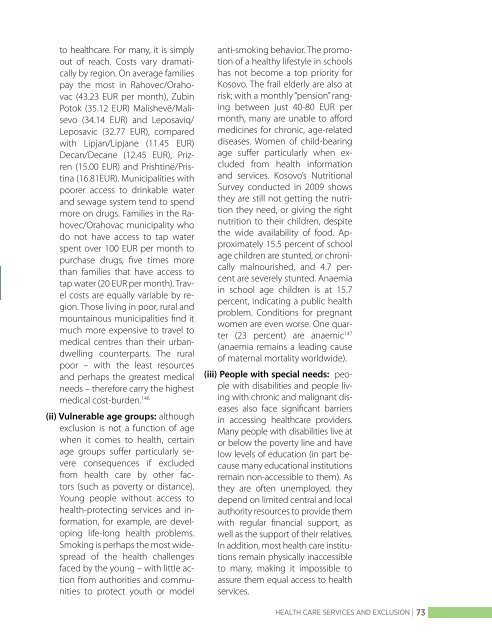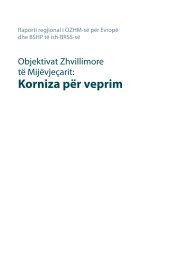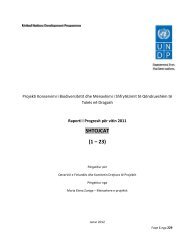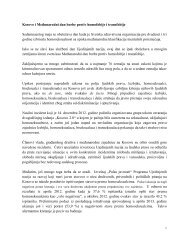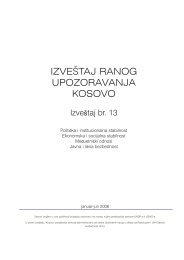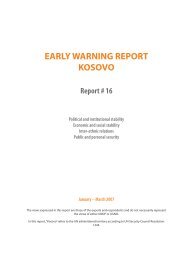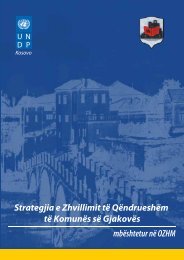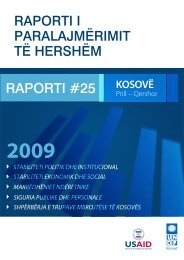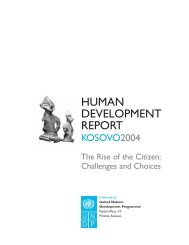Kosovo Human Development Report 2010 - UNDP Kosovo - United ...
Kosovo Human Development Report 2010 - UNDP Kosovo - United ...
Kosovo Human Development Report 2010 - UNDP Kosovo - United ...
You also want an ePaper? Increase the reach of your titles
YUMPU automatically turns print PDFs into web optimized ePapers that Google loves.
to healthcare. For many, it is simply<br />
out of reach. Costs vary dramatically<br />
by region. On average families<br />
pay the most in Rahovec/Orahovac<br />
(43.23 EUR per month), Zubin<br />
Potok (35.12 EUR) Malishevë/Malisevo<br />
(34.14 EUR) and Leposaviq/<br />
Leposavic (32.77 EUR), compared<br />
with Lipjan/Lipjane (11.45 EUR)<br />
Decan/Decane (12.45 EUR), Prizren<br />
(15.00 EUR) and Prishtinë/Pristina<br />
(16.81EUR). Municipalities with<br />
poorer access to drinkable water<br />
and sewage system tend to spend<br />
more on drugs. Families in the Rahovec/Orahovac<br />
municipality who<br />
do not have access to tap water<br />
spent over 100 EUR per month to<br />
purchase drugs, five times more<br />
than families that have access to<br />
tap water (20 EUR per month). Travel<br />
costs are equally variable by region.<br />
Those living in poor, rural and<br />
mountainous municipalities find it<br />
much more expensive to travel to<br />
medical centres than their urbandwelling<br />
counterparts. The rural<br />
poor – with the least resources<br />
and perhaps the greatest medical<br />
needs – therefore carry the highest<br />
medical cost-burden. 146<br />
(ii) Vulnerable age groups: although<br />
exclusion is not a function of age<br />
when it comes to health, certain<br />
age groups suffer particularly severe<br />
consequences if excluded<br />
from health care by other factors<br />
(such as poverty or distance).<br />
Young people without access to<br />
health-protecting services and information,<br />
for example, are developing<br />
life-long health problems.<br />
Smoking is perhaps the most widespread<br />
of the health challenges<br />
faced by the young – with little action<br />
from authorities and communities<br />
to protect youth or model<br />
anti-smoking behavior. The promotion<br />
of a healthy lifestyle in schools<br />
has not become a top priority for<br />
<strong>Kosovo</strong>. The frail elderly are also at<br />
risk; with a monthly “pension” ranging<br />
between just 40-80 EUR per<br />
month, many are unable to afford<br />
medicines for chronic, age-related<br />
diseases. Women of child-bearing<br />
age suffer particularly when excluded<br />
from health information<br />
and services. <strong>Kosovo</strong>’s Nutritional<br />
Survey conducted in 2009 shows<br />
they are still not getting the nutrition<br />
they need, or giving the right<br />
nutrition to their children, despite<br />
the wide availability of food. Approximately<br />
15.5 percent of school<br />
age children are stunted, or chronically<br />
malnourished, and 4.7 percent<br />
are severely stunted. Anaemia<br />
in school age children is at 15.7<br />
percent, indicating a public health<br />
problem. Conditions for pregnant<br />
women are even worse. One quarter<br />
(23 percent) are anaemic 147<br />
(anaemia remains a leading cause<br />
of maternal mortality worldwide).<br />
(iii) People with special needs: people<br />
with disabilities and people living<br />
with chronic and malignant diseases<br />
also face significant barriers<br />
in accessing healthcare providers.<br />
Many people with disabilities live at<br />
or below the poverty line and have<br />
low levels of education (in part because<br />
many educational institutions<br />
remain non-accessible to them). As<br />
they are often unemployed, they<br />
depend on limited central and local<br />
authority resources to provide them<br />
with regular financial support, as<br />
well as the support of their relatives.<br />
In addition, most health care institutions<br />
remain physically inaccessible<br />
to many, making it impossible to<br />
assure them equal access to health<br />
services.<br />
HEALTH CARE SERVICES AND EXCLUSION<br />
| 73


